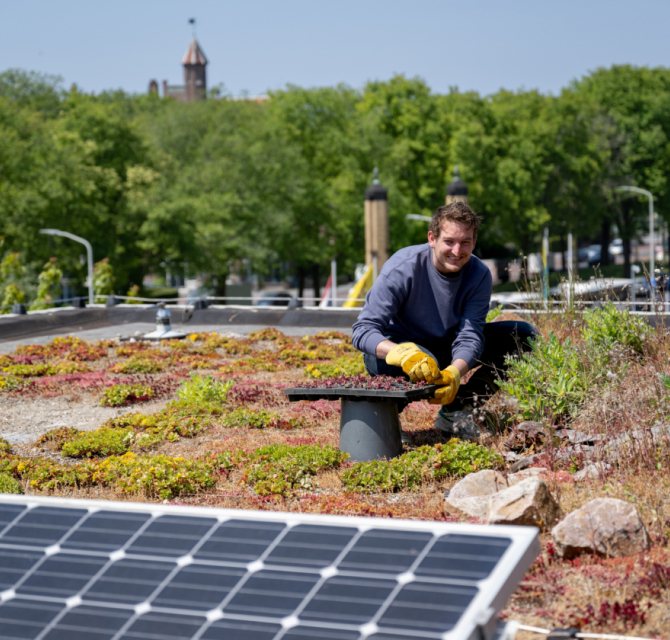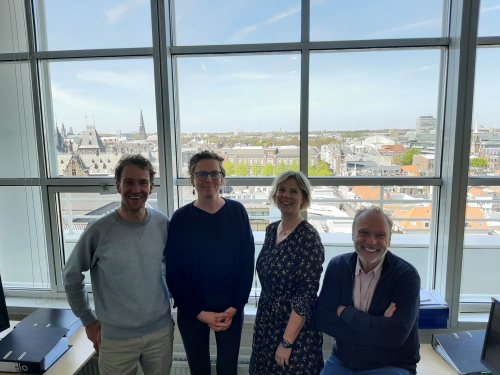
The municipality roof team explains how to maximize rooftop potential
6 October 2023
The Hague faces a challenge with its limited street-level space, especially when it comes to sustainable initiatives. However, amidst the hustle and bustle of our city, an often-overlooked opportunity exists right above our heads – rooftops. The municipality of The Hague has recognized these untapped resources and is shifting its focus upwards. Roofs can be transformed into versatile spaces, accommodating gardens, solar panels, catering industries, sport facilities, and more. In essence, they represent an entirely new frontier within our city. SDGs The Hague recently engaged with the masterminds behind the ‘Roofs Program’ to explore this innovative approach.
Be creative with space
“Our motto is simple: Unlock the full potential of your roof,” declares Onno, a member of the roof team. “There is still about 17 square kilometres of unused rooftop space in The Hague.” To put it into perspective, that is equivalent to 17 times the size of the Zuiderpark or 2600 soccer fields. The possibilities are endless. The roof team has identified various functions for these rooftops. They can serve as sources of sustainable energy generation or rainwater collection. Rooftop gardens can enhance biodiversity, mitigate heat stress, and purify the air. Or you can literally ‘raise the roof’ by adding new levels. The potential is boundless. “Five or ten years ago, the idea of harnessing rooftop potential was unheard of. However, in recent years, the tide has turned, and enthusiasm has surged. People are now realizing that they possess valuable rooftops pace that can be used to generate energy or create green gardens. Moreover, the global energy crisis has further accelerated interest in solar panels”, Onno explains.

Residents in action
The roof team has developed a strategy to carry out urban tasks on roofs, but the practicalities involved can be challenging. Not every rooftop is technically suitable, and they often belong to homeowners. Hence, it's crucial for the municipality to foster even stronger collaboration with a variety of city stakeholders, including its residents. Eveliene offers an example: "We are currently engaged in discussions with real estate entities along Grote Marktstraat to explore how rooftops can be leveraged to combat flooding." Another inspiring instance comes from the Vruchtenbuurt, where 177 solar panels were recently installed on top of a former school building. This endeavour was made possible through the joint efforts of local residents and an energy cooperative, with the municipality facilitating the rooftop's availability. This remarkable case demonstrates that residents can invest in green energy, even if they don't own the rooftop. To realize these ambitious plans, it's essential to ensure that residents have access to critical information. "We are in the process of developing a website where residents can readily find information on subsidy programs. Furthermore, with the Zonnewijzer, people can easily determine whether they require a permit to install solar panels," adds Cor. "Our primary goal is to create awareness and ignite inspiration among the populace. This is a long-term project that necessitates a fundamental shift in our perspective on urban development," emphasizes Anouk.
Sustainable city
The municipality's innovative approach of harnessing rooftops for sustainable energy generation and green initiatives aligns seamlessly with several United Nations Sustainable Development Goals (SDGs). In particular, our efforts contribute significantly to Goal 11, aimed at fostering sustainable cities and communities, Goal 7, which seeks to promote affordable and sustainable energy solutions, and Goal 13, focused on combating climate change. "At our core, we are driven by a profound commitment to sustainability. While some of our colleagues focus on the ground, we, the roof team, are dedicated to uplifting our city through the skies," explains Anouk. “By 2030, 50% of The Hague's roofs will be green and yellow. The color yellow represents our dedication to solar energy, a symbol of our belief that everyone should have access to clean and sustainable power, irrespective of their housing situation or financial status. And the colour green signifies our commitment to enhancing biodiversity and urban green spaces. Echoing the colours of The Hague”.
More information
Do you have a roof yourself and are you curious about what is possible? Then take a look at this website duurstad.denhaag.nl. Furthermore, the event 'Uit je Dak' will take place from 3 to 22 October 2023 for anyone who wants to know more about roofs.